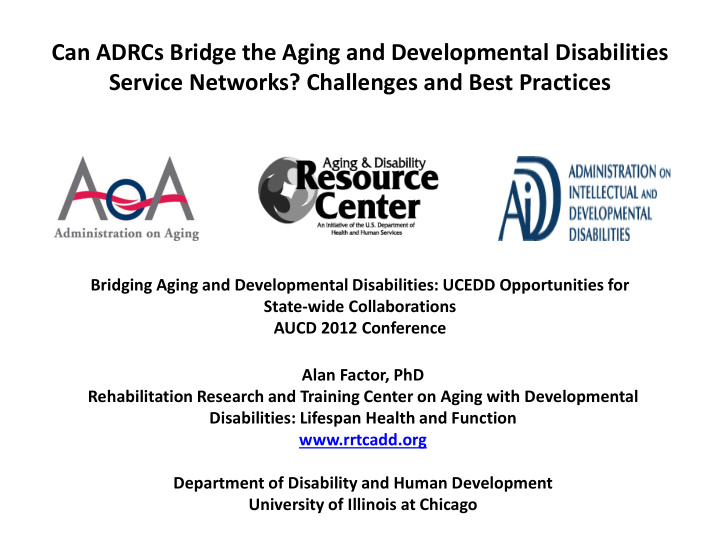



Can ADRCs Bridge the Aging and Developmental Disabilities Service Networks? Challenges and Best Practices Bridging Aging and Developmental Disabilities: UCEDD Opportunities for State-wide Collaborations AUCD 2012 Conference Alan Factor, PhD Rehabilitation Research and Training Center on Aging with Developmental Disabilities: Lifespan Health and Function www.rrtcadd.org Department of Disability and Human Development University of Illinois at Chicago
Bridging Aging and I/DD Service Networks: A Long-Term Courtship • Wingspread Conference • Cooperative agreements between state aging and DD authorities • Older Americans Act and DD Act Amendments • AoA and ADD Discretionary Grants • MoU between AoA and ADD
Aging and Disability Resource Centers • Community-based “one-stop shops” for information and access to long-term services and supports (LTSS) • Single entry point for LTSS funded by OAA, Medicaid, and state revenues • ADRCs target older persons and at least one other population of people with PD, IDD, and/or SPMI • 54 states and territories have received AoA/CMS ADRC grant funding since 2003.
ADRC Goals • Be an integral part of health and LTSS reform • Enable states to redesign and better coordinate LTSS services • Support individuals to make informed choices about meeting LTSS needs • Streamline access to services
ADRC Functions • Provide information, referral, and awareness • Provide options counseling • Streamline eligibility determination • Person-centered transition support • Quality assurance and continuous improvement
ADRCs : A Key Player in State LTSS • Alzheimer’s Disease Supportive Services Program • Community Living Program • Care Transitions • Money Follows the Person • Hospital Discharge Planning Model • Options Counseling Standards • Systems Integration • Veterans’ Directed HCBS
Similarities of Older Americans Act and ADD Envisioning Session Objectives Older Americans Act Objectives ADD Envisioning Session Priorities Access to the best possible health care Improved access to quality health care. Opportunities for a wide range of Participate in a welcoming, inclusive meaningful community activities. community. Able to select affordable housing that is Provide incentives for affordable accessible housing. designed and located to meet special needs. Adequate income in retirement. Improved economic self-sufficiency. Coordinated community support Access to quality home and community services and supports. services that are meaningful, efficient, and available when needed. Promote and support self determination. Freedom, independence, and the free exercise of individual initiative in planning and managing one’s life. Avoidance of institutional care. Elimination of congregate care. Use proven research knowledge to Disseminate information and research to inform best practices. sustain and improve health and happiness. Increased access to employment. Opportunities for employment without age discrimination.
Number of Persons Served by the ADRC National Program April 1, 2006 – March 31, 2011 Disability* Number of Persons Served Physical Disability 448,553 Developmental Disability 113,812 Mental Illness 124,198 Traumatic Brain Injury** 10,473 Dementia** 40,055 Multiple Disabilities 96,025 Disability 2,677,018 Unspecified/Unknown Total People with 3,510,134 Disabilities Age Group Age 60+ 2,047,510 Under Age 60 694,428 Age Unknown 949,409
ADRC Outreach to People with Developmental Disabilities
Differences Between Aging and DD Service Systems Issue Aging Developmental Disabilities Core funding Federal State Service Network Uniform Fragmented Entitlement Age-based State/federal definition of DD Service Gatekeeper Area Agency on Aging State DD Agency I&A Activity Strong Weak Avg. Annual Waiver Cost $9,510 $42,896 Avg. Wait for Waiver Svcs. 9 months 36 months
States with ADRCs Serving Large Numbers of People with Developmental Disabilities: October 1, 2010 to March 31, 2011 State Years I/DD % of All Physical Age 60+ No. of ADRCs Operating Disabilitie Disability s GA 12 1 – 6 37,662 70 6,037 40,998 WI 35 1 – 6 8,333 17 29,535 92,810 AZ 5 1 – 4 3,558 62 2,436 8,145 TX 11 <1 – 4 1,396 42 1,662 10,514 MA 11 3 – 7 664 8 6,492 46,296 AK 4 1 – 7 401 25 749 1,653 TBI: Traumatic Brain Injury Source: The Lewin Group. Special tabulation of ADRC clients by age and disability
ADRC Best Practices to Bridge the Aging and DD Networks • Disability-friendly websites and brochures • Advisory groups include people with developmental disabilities and families • ADRC lead agency (AAA) allocates grant funds to collaborating partners (I/DD agency) • Cross-training and technical assistance • Use aging waiver to fund HCBS for older adults with DD
Georgia Brochure
UCEDD Collaborations with ADRCs • Collaborations limited to few states • UCEDDs involved multiple activities: – Trained ADRC staff 82% – Served on ADRC advisory committee 73% – Provided technical assistance 73% – Evaluated ADRC performance 45%
Potential Benefits of ADRCs for People with I/DD and Their Families Provide a uniform national model to enhance collaboration across • service systems Facilitate joint service coordination with the family as the unit of • focus • Both service networks can mutually benefit from the expertise and resources each bring to the table • Jointly advocate to insure quality in managed care LTSS and health care for people enrolled in both Medicare and Medicaid • Jointly develop training to enhance core competencies of direct support professionals
Administration for Community Living • Raises the visibility of developmental disabilities concerns in policy reforms. • Possibly the first step in dismantling the aging and disability networks’ silos. • May provide AIDD with a voice in setting ADRC policy
Recommend
More recommend